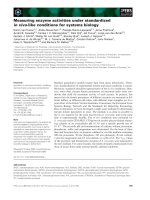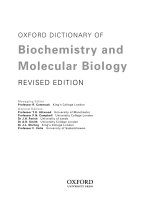Stochastic modelling for systems biology, second edition (1)
Bạn đang xem bản rút gọn của tài liệu. Xem và tải ngay bản đầy đủ của tài liệu tại đây (6.87 MB, 360 trang )
Bioinformatics
Second
Edition
Since the first edition of Stochastic Modelling for Systems Biology, there have
been many interesting developments in the use of “likelihood-free” methods
of Bayesian inference for complex stochastic models. Re-written to reflect this
modern perspective, this second edition covers everything necessary for a good
appreciation of stochastic kinetic modelling of biological networks in the systems
biology context.
Keeping with the spirit of the first edition, all of the new theory is presented in a
very informal and intuitive manner, keeping the text as accessible as possible to
the widest possible readership.
New in the Second Edition
• All examples have been updated to Systems Biology Markup Language
Level 3
• All code relating to simulation, analysis, and inference for stochastic kinetic
models has been rewritten and restructured in a more modular way
• An ancillary website provides links, resources, errata, and up-to-date
information on installation and use of the associated R package
• More background material on the theory of Markov processes and
stochastic differential equations, providing more substance for
mathematically inclined readers
• Discussion of some of the more advanced concepts relating to stochastic
kinetic models, such as random time change representations, Kolmogorov
equations, Fokker–Planck equations and the linear noise approximation
• Simple modelling of “extrinsic” and “intrinsic” noise
K11715
K11715_Cover.indd 1
Stochastic Modelling
for Systems Biology
SECOND EDITION
Wilkinson
An effective introduction to the area of stochastic modelling in computational
systems biology, this new edition adds additional mathematical detail and
computational methods which will provide a stronger foundation for the
development of more advanced courses in stochastic biological modelling.
Stochastic Modelling for Systems Biology
Praise for the First Edition
“…well suited as an in-depth introduction into stochastic chemical simulation,
both for self-study or as a course text…”
—Biomedical Engineering Online, December 2006
Darren J. Wilkinson
10/7/11 8:55 AM
Stochastic Modelling
for Systems Biology
SECOND EDITION
K11715_FM.indd 1
10/3/11 10:33 AM
CHAPMAN & HALL/CRC
Mathematical and Computational Biology Series
Aims and scope:
This series aims to capture new developments and summarize what is known
over the entire spectrum of mathematical and computational biology and
medicine. It seeks to encourage the integration of mathematical, statistical,
and computational methods into biology by publishing a broad range of
textbooks, reference works, and handbooks. The titles included in the
series are meant to appeal to students, researchers, and professionals in the
mathematical, statistical and computational sciences, fundamental biology
and bioengineering, as well as interdisciplinary researchers involved in the
field. The inclusion of concrete examples and applications, and programming
techniques and examples, is highly encouraged.
Series Editors
N. F. Britton
Department of Mathematical Sciences
University of Bath
Xihong Lin
Department of Biostatistics
Harvard University
Hershel M. Safer
School of Computer Science
Tel Aviv University
Maria Victoria Schneider
European Bioinformatics Institute
Mona Singh
Department of Computer Science
Princeton University
Anna Tramontano
Department of Biochemical Sciences
University of Rome La Sapienza
Proposals for the series should be submitted to one of the series editors above or directly to:
CRC Press, Taylor & Francis Group
4th, Floor, Albert House
1-4 Singer Street
London EC2A 4BQ
UK
K11715_FM.indd 2
10/3/11 10:33 AM
Published Titles
Algorithms in Bioinformatics: A Practical
Introduction
Wing-Kin Sung
Exactly Solvable Models of Biological
Invasion
Sergei V. Petrovskii and Bai-Lian Li
Bioinformatics: A Practical Approach
Shui Qing Ye
Gene Expression Studies Using
Affymetrix Microarrays
Hinrich Göhlmann and Willem Talloen
Biological Computation
Ehud Lamm and Ron Unger
Biological Sequence Analysis Using
the SeqAn C++ Library
Andreas Gogol-Döring and Knut Reinert
Glycome Informatics: Methods and
Applications
Kiyoko F. Aoki-Kinoshita
Cancer Modelling and Simulation
Luigi Preziosi
Handbook of Hidden Markov Models
in Bioinformatics
Martin Gollery
Cancer Systems Biology
Edwin Wang
Introduction to Bioinformatics
Anna Tramontano
Cell Mechanics: From Single ScaleBased Models to Multiscale Modeling
Arnaud Chauvière, Luigi Preziosi,
and Claude Verdier
Introduction to Bio-Ontologies
Peter N. Robinson and Sebastian Bauer
Clustering in Bioinformatics and Drug
Discovery
John D. MacCuish and Norah E. MacCuish
Combinatorial Pattern Matching
Algorithms in Computational Biology
Using Perl and R
Gabriel Valiente
Computational Biology: A Statistical
Mechanics Perspective
Ralf Blossey
Computational Hydrodynamics of
Capsules and Biological Cells
C. Pozrikidis
Computational Neuroscience:
A Comprehensive Approach
Jianfeng Feng
Introduction to Computational
Proteomics
Golan Yona
Introduction to Proteins: Structure,
Function, and Motion
Amit Kessel and Nir Ben-Tal
An Introduction to Systems Biology:
Design Principles of Biological Circuits
Uri Alon
Kinetic Modelling in Systems Biology
Oleg Demin and Igor Goryanin
Knowledge Discovery in Proteomics
Igor Jurisica and Dennis Wigle
Meta-analysis and Combining
Information in Genetics and Genomics
Rudy Guerra and Darlene R. Goldstein
Data Analysis Tools for DNA Microarrays
Sorin Draghici
Methods in Medical Informatics:
Fundamentals of Healthcare
Programming in Perl, Python, and Ruby
Jules J. Berman
Differential Equations and Mathematical
Biology, Second Edition
D.S. Jones, M.J. Plank, and B.D. Sleeman
Modeling and Simulation of Capsules
and Biological Cells
C. Pozrikidis
Dynamics of Biological Systems
Michael Small
Niche Modeling: Predictions from
Statistical Distributions
David Stockwell
Engineering Genetic Circuits
Chris J. Myers
K11715_FM.indd 3
10/3/11 10:33 AM
Published Titles (continued)
Normal Mode Analysis: Theory and
Applications to Biological and Chemical
Systems
Qiang Cui and Ivet Bahar
Statistics and Data Analysis for
Microarrays Using R and Bioconductor,
Second Edition
˘
Sorin Draghici
Optimal Control Applied to Biological
Models
Suzanne Lenhart and John T. Workman
Stochastic Modelling for Systems
Biology, Second Edition
Darren J. Wilkinson
Pattern Discovery in Bioinformatics:
Theory & Algorithms
Laxmi Parida
Structural Bioinformatics: An Algorithmic
Approach
Forbes J. Burkowski
Python for Bioinformatics
Sebastian Bassi
The Ten Most Wanted Solutions in
Protein Bioinformatics
Anna Tramontano
Spatial Ecology
Stephen Cantrell, Chris Cosner, and
Shigui Ruan
Spatiotemporal Patterns in Ecology
and Epidemiology: Theory, Models,
and Simulation
Horst Malchow, Sergei V. Petrovskii, and
Ezio Venturino
K11715_FM.indd 4
10/3/11 10:33 AM
Stochastic Modelling
for Systems Biology
SECOND EDITION
Darren J. Wilkinson
K11715_FM.indd 5
10/3/11 10:33 AM
CRC Press
Taylor & Francis Group
6000 Broken Sound Parkway NW, Suite 300
Boca Raton, FL 33487-2742
© 2012 by Taylor & Francis Group, LLC
CRC Press is an imprint of Taylor & Francis Group, an Informa business
No claim to original U.S. Government works
Version Date: 2011926
International Standard Book Number-13: 978-1-4398-3776-4 (eBook - PDF)
This book contains information obtained from authentic and highly regarded sources. Reasonable efforts
have been made to publish reliable data and information, but the author and publisher cannot assume
responsibility for the validity of all materials or the consequences of their use. The authors and publishers
have attempted to trace the copyright holders of all material reproduced in this publication and apologize to
copyright holders if permission to publish in this form has not been obtained. If any copyright material has
not been acknowledged please write and let us know so we may rectify in any future reprint.
Except as permitted under U.S. Copyright Law, no part of this book may be reprinted, reproduced, transmitted, or utilized in any form by any electronic, mechanical, or other means, now known or hereafter invented,
including photocopying, microfilming, and recording, or in any information storage or retrieval system,
without written permission from the publishers.
For permission to photocopy or use material electronically from this work, please access www.copyright.
com ( or contact the Copyright Clearance Center, Inc. (CCC), 222 Rosewood
Drive, Danvers, MA 01923, 978-750-8400. CCC is a not-for-profit organization that provides licenses and
registration for a variety of users. For organizations that have been granted a photocopy license by the CCC,
a separate system of payment has been arranged.
Trademark Notice: Product or corporate names may be trademarks or registered trademarks, and are used
only for identification and explanation without intent to infringe.
Visit the Taylor & Francis Web site at
and the CRC Press Web site at
Contents
List of tables
xi
List of figures
xiii
Author biography
xix
Acknowledgements
xxi
Preface to the second edition
xxiii
Preface to the first edition
xxv
I Modelling and networks
1
1 Introduction to biological modelling
1.1 What is modelling?
1.2 Aims of modelling
1.3 Why is stochastic modelling necessary?
1.4 Chemical reactions
1.5 Modelling genetic and biochemical networks
1.6 Modelling higher-level systems
1.7 Exercises
1.8 Further reading
3
3
4
4
9
10
18
20
20
2 Representation of biochemical networks
2.1 Coupled chemical reactions
2.2 Graphical representations
2.3 Petri nets
2.4 Stochastic process algebras
2.5 Systems Biology Markup Language (SBML)
2.6 SBML-shorthand
2.7 Exercises
2.8 Further reading
21
21
21
24
34
36
41
47
48
vii
viii
CONTENTS
II Stochastic processes and simulation
49
3 Probability models
3.1 Probability
3.2 Discrete probability models
3.3 The discrete uniform distribution
3.4 The binomial distribution
3.5 The geometric distribution
3.6 The Poisson distribution
3.7 Continuous probability models
3.8 The uniform distribution
3.9 The exponential distribution
3.10 The normal/Gaussian distribution
3.11 The gamma distribution
3.12 Quantifying “noise”
3.13 Exercises
3.14 Further reading
51
51
62
70
71
72
74
77
82
85
89
93
96
97
98
4 Stochastic simulation
4.1 Introduction
4.2 Monte Carlo integration
4.3 Uniform random number generation
4.4 Transformation methods
4.5 Lookup methods
4.6 Rejection samplers
4.7 Importance resampling
4.8 The Poisson process
4.9 Using the statistical programming language, R
4.10 Analysis of simulation output
4.11 Exercises
4.12 Further reading
99
99
99
100
101
106
107
110
111
112
118
120
122
5 Markov processes
5.1 Introduction
5.2 Finite discrete time Markov chains
5.3 Markov chains with continuous state-space
5.4 Markov chains in continuous time
5.5 Diffusion processes
5.6 Exercises
5.7 Further reading
123
123
123
130
137
152
166
168
III
169
Stochastic chemical kinetics
6 Chemical and biochemical kinetics
6.1 Classical continuous deterministic chemical kinetics
171
171
CONTENTS
6.2
6.3
6.4
6.5
6.6
6.7
6.8
6.9
6.10
6.11
Molecular approach to kinetics
Mass-action stochastic kinetics
The Gillespie algorithm
Stochastic Petri nets (SPNs)
Structuring stochastic simulation codes
Rate constant conversion
Kolmogorov’s equations and other analytic representations
Software for simulating stochastic kinetic networks
Exercises
Further reading
ix
178
180
182
183
186
189
194
199
200
200
7 Case studies
7.1 Introduction
7.2 Dimerisation kinetics
7.3 Michaelis–Menten enzyme kinetics
7.4 An auto-regulatory genetic network
7.5 The lac operon
7.6 Exercises
7.7 Further reading
203
203
203
208
212
217
219
220
8 Beyond the Gillespie algorithm
8.1 Introduction
8.2 Exact simulation methods
8.3 Approximate simulation strategies
8.4 Hybrid simulation strategies
8.5 Exercises
8.6 Further reading
221
221
221
226
239
245
245
IV
247
Bayesian inference
9 Bayesian inference and MCMC
9.1 Likelihood and Bayesian inference
9.2 The Gibbs sampler
9.3 The Metropolis–Hastings algorithm
9.4 Hybrid MCMC schemes
9.5 Metropolis–Hastings algorithms for Bayesian inference
9.6 Bayesian inference for latent variable models
9.7 Alternatives to MCMC
9.8 Exercises
9.9 Further reading
249
249
254
264
268
269
270
274
275
275
10 Inference for stochastic kinetic models
10.1 Introduction
10.2 Inference given complete data
10.3 Discrete-time observations of the system state
277
277
278
281
10.4
10.5
10.6
10.7
10.8
Diffusion approximations for inference
Likelihood-free methods
Network inference and model comparison
Exercises
Further reading
288
292
308
309
310
11 Conclusions
311
Appendix A SBML Models
A.1 Auto-regulatory network
A.2 Lotka–Volterra reaction system
A.3 Dimerisation-kinetics model
315
315
318
319
References
323
Index
331
x
List of tables
2.1
2.2
The auto-regulatory system displayed in tabular (matrix) form (zero
stoichiometries omitted for clarity)
Table representing the overall effect of each transition (reaction) on
the marking (state) of the network
xi
27
28
This page intentionally left blank
List of figures
1.1
1.2
1.3
1.4
1.5
1.6
1.7
1.8
2.1
2.2
2.3
2.4
2.5
Five deterministic solutions of the linear birth–death process for
values of λ − µ given in the legend (x0 = 50).
Five realisations of a stochastic linear birth–death process together
with the continuous deterministic solution (x0 = 50, λ = 3, µ = 4).
Five realisations of a stochastic linear birth–death process together
with the continuous deterministic solution for four different (λ, µ)
combinations, each with λ − µ = −1 and x0 = 50.
Transcription of a single prokaryotic gene.
A simple illustrative model of the transcription process in eukaryotic
cells.
A simple prokaryotic transcription repression mechanism.
A very simple model of a prokaryotic auto-regulatory gene network.
Key mechanisms involving the lac operon.
6
7
8
11
13
14
17
18
A simple graph of the auto-regulatory reaction network.
A simple digraph.
A Petri net for the auto-regulatory reaction network.
A Petri net labelled with tokens.
A Petri net with new numbers of tokens after reactions have taken
place.
22
23
24
25
3.1
3.2
3.3
3.4
3.5
3.6
3.7
3.8
CDF for the sum of a pair of fair dice.
PMF and CDF for a Bin(8, 0.7) distribution.
PMF and CDF for a P o(5) distribution.
PDF and CDF for a U (0, 1) distribution.
PDF and CDF for an Exp(1) distribution.
PDF and CDF for a N (0, 1) distribution.
Graph of Γ(x) for small positive values of x.
PDF and CDF for a Ga(3, 1) distribution.
64
71
75
83
85
91
94
95
4.1
4.2
Density of Y = exp(X), where X ∼ N (2, 1).
Normal Q–Q plot for the samples resulting from the importance
resampling procedure, showing good agreement with the theoretical
distribution.
xiii
25
120
121
xiv
LIST OF FIGURES
An R function to simulate a sample path of length n from a Markov
chain with transition matrix P and initial distribution pi0.
5.2 A sample R session to simulate and analyse the sample path of a
finite Markov chain.
5.3 SBML-shorthand for the simple gene activation process with
α = 0.5 and β = 1.
5.4 A simulated realisation of the simple gene activation process with
α = 0.5 and β = 1.
5.5 An R function to simulate a sample path with n events from a
continuous time Markov chain with transition rate matrix Q and
initial distribution pi0.
5.6 SBML-shorthand for the immigration-death process with λ = 1 and
µ = 0.1.
5.7 A single realisation of the immigration-death process with parameters λ = 1 and µ = 0.1, initialised at X(0) = 0.
5.8 R function for discrete-event simulation of the immigration-death
process.
5.9 R function for simulation of a diffusion process using the Euler
method.
5.10 A single realisation of the diffusion approximation to the immigrationdeath process with parameters λ = 1 and µ = 0.1, initialised at
X(0) = 0.
5.11 R code for simulating the diffusion approximation to the immigrationdeath process.
5.1
Lotka–Volterra dynamics for [Y1 ](0) = 4, [Y2 ](0) = 10, k1 =
1, k2 = 0.1, k3 = 0.1. Note that the equilibrium solution for this
combination of rate parameters is [Y1 ] = 1, [Y2 ] = 10.
6.2 Lotka–Volterra dynamics in phase-space for rate parameters k1 =
1, k2 = 0.1, k3 = 0.1.
6.3 Dimerisation kinetics.
6.4 An R function to numerically integrate a system of coupled ODEs
using a simple first-order Euler method.
6.5 An R function to implement the Gillespie algorithm for a stochastic
Petri net representation of a coupled chemical reaction system.
6.6 Some R code to set up the LV system as a SPN and then simulate it
using the Gillespie algorithm.
6.7 A single realisation of a stochastic LV process.
6.8 A single realisation of a stochastic LV process in phase-space.
6.9 SBML-shorthand for the stochastic Lotka–Volterra system.
6.10 An R function to discretise the output of gillespie onto a regular
grid of time points.
6.11 An R function to implement the Gillespie algorithm for a SPN,
recording the state on a regular grid of time points.
130
131
140
142
143
144
145
146
154
155
155
6.1
173
174
175
177
184
185
186
187
188
189
190
LIST OF FIGURES
6.12 An R function which accepts as input an SPN, and returns as output
a function (closure) for advancing the state of the SPN using the
Gillespie algorithm.
6.13 An R function to simulate a process on a regular time grid using a
stepping function such as output by StepGillespie.
6.14 R code showing how to use the functions StepGillespie and
simTs together in order to simulate a realisation from a SPN.
SBML-shorthand for the dimerisation kinetics model (continuous
deterministic version).
7.2 Left: Simulated continuous deterministic dynamics of the dimerisation kinetics model. Right: A simulated realisation of the discrete
stochastic dynamics of the dimerisation kinetics model.
7.3 SBML-shorthand for the dimerisation kinetics model (discrete
stochastic version).
7.4 R code to build an SPN object representing the dimerisation kinetics
model.
7.5 Left: A simulated realisation of the discrete stochastic dynamics of
the dimerisation kinetics model plotted on a concentration scale.
Right: The trajectories for levels of P from 20 runs overlaid.
7.6 Left: The mean trajectory of P together with some approximate
(point-wise) “confidence bounds” based on 1,000 runs of the
simulator. Right: Density histogram of the simulated realisations of
P at time t = 10 based on 10,000 runs, giving an estimate of the
PMF for P (10).
7.7 SBML-shorthand for the Michaelis–Menten kinetics model (continuous deterministic version).
7.8 Left: Simulated continuous deterministic dynamics of the Michaelis–
Menten kinetics model. Right: Simulated continuous deterministic
dynamics of the Michaelis–Menten kinetics model based on the
two-dimensional representation.
7.9 SBML-shorthand for the Michaelis–Menten kinetics model (discrete
stochastic version).
7.10 Left: A simulated realisation of the discrete stochastic dynamics of
the Michaelis–Menten kinetics model. Right: A simulated realisation
of the discrete stochastic dynamics of the reduced-dimension
Michaelis–Menten kinetics model.
7.11 SBML-shorthand for the reduced dimension Michaelis–Menten
kinetics model (discrete stochastic version).
7.12 Left: A simulated realisation of the discrete stochastic dynamics
of the prokaryotic genetic auto-regulatory network model, for a
period of 5,000 seconds. Right: A close-up on the first period of 250
seconds of the left plot.
xv
191
192
192
7.1
204
205
205
206
207
207
210
210
212
212
213
214
xvi
LIST OF FIGURES
7.13 Left: Close-up showing the time-evolution of the number of
molecules of P over a 10-second period. Right: Empirical PMF
for the number of molecules of P at time t = 10 seconds, based on
10,000 runs.
7.14 Left: Empirical PMF for the number of molecules of P at time
t = 10 seconds when k2 is changed from 0.01 to 0.02, based
on 10,000 runs. Right: Empirical PMF for the prior predictive
uncertainty regarding the observed value of P at time t = 10 based
on the prior distribution k2 ∼ U (0.005, 0.03).
7.15 SBML-shorthand for the lac-operon model (discrete stochastic
version).
7.16 A simulated realisation of the discrete stochastic dynamics of the
lac-operon model for a period of 50,000 seconds.
8.1
8.2
8.3
8.4
8.5
8.6
9.1
9.2
9.3
9.4
9.5
9.6
An R function to implement the first reaction method for a stochastic
Petri net representation of a coupled chemical reaction system.
An R function to implement the Poisson timestep method for a
stochastic Petri net representation of a coupled chemical reaction
system.
An R function to integrate the CLE using an Euler method for a
stochastic Petri net representation of a coupled chemical reaction
system.
An R function to integrate a multivariate diffusion process using a
simple Euler–Maruyama method.
Example showing how to use the function StepSDE for the SDE
given in (8.4).
Figure showing realisations of the SDE models for the immigrationdeath process discussed in Section 8.3.4 incorporating different
combinations of intrinsic and extrinsic noise.
Plot showing the prior and posterior for the Poisson rate example.
An R function to implement a Gibbs sampler for the simple normal
random sample model.
Example R code illustrating the use of the function normgibbs
from Figure 9.2.
Figure showing the Gibbs sampler output resulting from running the
example code in Figure 9.3.
An R function to implement a Metropolis sampler for a standard
normal random quantity based on U (−α, α) innovations.
Output from the Metropolis sampler given in Figure 9.5.
10.1 An R function to create a function closure for marginal likelihood
estimation using a bootstrap particle filter.
10.2 An R session showing how to use the function pfMLLik from
Figure 10.1.
215
216
218
219
223
228
232
235
236
237
252
259
260
261
268
269
296
297
10.3 Simulated time series data set, LVnoise10, consisting of 16
equally spaced observations of a realisation of a stochastic kinetic
Lotka–Volterra model subject to Gaussian measurement error with a
standard deviation of 10.
10.4 R code implementing an MCMC sampler for fully Bayesian
inference for the stochastic Lotka–Volterra model using time course
data.
10.5 Marginal posterior distributions for the parameters of the Lotka–
Volterra model, based on the data given in Figure 10.3.
10.6 Marginal posterior distributions for the parameters of the Lotka–
Volterra model, based only on observations of prey species levels.
10.7 Marginal posterior distributions for the parameters of the Lotka–
Volterra model with unknown measurement error standard deviation.
10.8 Marginal posterior distributions for the log-parameters of the Lotka–
Volterra model with unknown measurement error standard deviation.
xvii
298
299
300
301
303
304
This page intentionally left blank
Author biography
Darren Wilkinson is professor of stochastic modelling at Newcastle University in
the United Kingdom. He was educated at the nearby University of Durham, where
he took his first degree in mathematics followed by a PhD in Bayesian statistics
which he completed in 1995. He moved to a lectureship in statistics at Newcastle
University in 1996, where he has remained since, being promoted to his current post
in 2007. Professor Wilkinson is interested in computational statistics and Bayesian
inference and in the application of modern statistical technology to problems in statistical bioinformatics and systems biology. He is involved in a variety of systems
biology projects at Newcastle, including the Centre for Integrated Systems Biology
of Ageing and Nutrition (CISBAN). He currently holds a BBSRC Research Development Fellowship on integrative modelling of stochasticity, noise, heterogeneity and
measurement error in the study of model biological systems.
xix
This page intentionally left blank
Acknowledgements
I would like to acknowledge the support of everyone at Newcastle University who is
involved with systems biology research. Unfortunately, there are far too many people
to mention by name, but particular thanks are due to everyone involved in the BBRSC
CISBAN project, without whom this book would never have been written.
The production of the second edition of this book has been greatly facilitated by
funding from the Biotechnology and Biological Sciences Research Council, both
through their funding of CISBAN (grant number BBC0082001) and the award to
me of a BBSRC Research Development Fellowship (grant number BBF0235451).
In addition, a considerable amount of work on this second edition was carried out
during a visit I made to the Statistical and Applied Mathematical Sciences Institute
(SAMSI, www.samsi.info) in North Carolina during the spring of 2011, as part
of their research programme on the Analysis of Object-Oriented Data.
Particular thanks are also due to all of the students who have been involved in the
MSc in bioinformatics and computational systems biology programme at Newcastle,
and especially those who took my course on Stochastic Systems Biology, as it was
the teaching of that course which persuaded me that it was necessary to write this
book.
Last, but by no means least, I would like to thank my family for supporting me in
everything that I do.
xxi
This page intentionally left blank
Preface to the second edition
I was keen to write a second edition of this book even before the first edition was published in the spring of 2006. The first edition was written during the latter half of 2004
and the first half of 2005 when the use of stochastic modelling within computational
systems biology was still very much in its infancy. Based on an inter-disciplinary
Masters course I was teaching I saw an urgent need for an introductory textbook in
this area, and tried in the first edition to lay down all of the key ingredients needed
to get started. I think that I largely succeeded, but the emphasis there was very much
on the “bare essentials” and accessibility to non-mathematical readers, and my goal
was to get the book published in a timely fashion, in order to help advance the field.
I would like to think that the first edition of this text has played a small role in helping to make stochastic modelling a much more mainstream part of computational
systems biology today. But naturally there were many limitations of the first edition. There were several places where I would have liked to have elaborated further,
providing additional details likely to be of interest to the more mathematically or statistically inclined reader. Also, the latter chapters on inference from data were rather
limited and lacking in concrete examples. This was partly due to the fact that the
whole area of inference for stochastic kinetic models was just developing, and so
it wasn’t possible to give a coherent overview of the problem from an introductory
viewpoint. Since publishing the first edition there have been many interesting developments in the use of “likelihood-free” methods of Bayesian inference for complex
stochastic models, and so the latter chapters have now been re-written to reflect this
more modern perspective, including a detailed case study accompanied by working
code examples.
Of course the whole field has moved on considerably since 2005, and so the second edition is also an opportunity to revise and update, and to change the emphasis
of the text slightly. The Systems Biology Markup Language (SBML) has continued to evolve, and SBML Level 3 is now finalised. Consequently, I have updated
all of the examples to Level 3, which is likely to remain the standard encoding for
dynamic biological models for the foreseeable future. I have also taken the opportunity to revise and update the R code examples associated with the book, and to
bundle them all together as an R package (smfsb). This should make it much easier
for people to try out the examples given in the book. I have also re-written and restructured all of the code relating to simulation, analysis and inference for stochastic
kinetic models. The code is now structured in a more modular way (using a functional
programming style), making it easy to “bolt together” different models, simulation
algorithms, and analysis tools. I’ve created a new website specific to this second
edition ( where
xxiii
xxiv
PREFACE TO THE SECOND EDITION
I will keep links, resources, an errata, and up-to-date information on installation and
use of the associated R package.
The new edition contains more background material on the theory of Markov processes and stochastic differential equations, providing more substance for mathematically inclined readers. This allows discussion of some of the more advanced concepts
relating to stochastic kinetic models, such as random time-change representations,
Kolmogorov equations, Fokker–Planck equations and the linear noise approximation. It also enables simple modelling of “extrinsic” in addition to “intrinsic” noise.
This should make the text suitable for use in a greater range of courses. Naturally, in
keeping with the spirit of the first edition, all of the new theory is presented in a very
informal and intuitive way, in order to keep the text accessible to the widest possible
readership. This is not a rigorous text on the theory of Markov processes (there are
plenty of other good texts in that vein) — the book is still intended for use in courses
for students with a life sciences background.
I’ve also updated the references, and provided new pointers to recent publications
in the literature where this is especially pertinent. However, it should be emphasised
that the book is not intended to provide a comprehensive survey of the stochastic
systems biology literature — I don’t think that is necessary (or even helpful) for an
introductory textbook, and I hope that people working in this area accept this if I fail
to cite their work.
So here it is, the second edition, completed at last. I hope that this text continues to
serve as an effective introduction to the area of stochastic modelling in computational
systems biology, and that this new edition adds additional mathematical detail and
computational methods which will provide a stronger foundation for the development
of more advanced courses in stochastic biological modelling.
Darren Wilkinson
Newcastle upon Tyne









